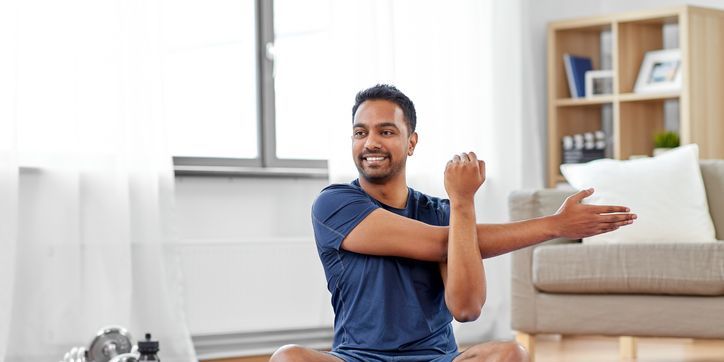Simple At-Home Exercises for Brain Tumor Patients

When you're recovering from a brain tumor or navigating treatment, movement might feel like the last thing on your to-do list. But gentle, consistent exercise (right from your own living room) can make a powerful difference. Whether you're dealing with fatigue, balance changes, or just not feeling like yourself, there are simple ways to get moving without pushing too hard.
Staying active during brain tumor treatment is important and part of a whole-person approach to healing. Let's walk through why it matters, how to get started safely, and a few low-impact activities you can try today.

Why Exercise Matters for Brain Tumor Patients
When you're coping with treatment side effects or post-surgical recovery, exercise might sound exhausting. But the right kind of movement isn’t about sweating or pushing your limits. It’s about gently supporting your body and brain as they heal.
Light activity can help:
- Improve balance, flexibility, and strength
- Reduce fatigue during brain tumor treatment and boost mood
- Support better sleep and appetite
- Promote neuroplasticity, the brain’s ability to form new connections and adapt
Even a few minutes of movement a day can lead to noticeable improvements over time.
Before You Start: What to Know
Before trying any new exercise routine, check in with your team of doctors, especially if you've recently had surgery or radiation. Safety is priority number one.
Here are a few smart tips:
- Start small: Begin with a few minutes and gradually increase over time.
- Hydrate: Hydration during brain tumor treatment, especially after exercising, is key. Keep water nearby and sip regularly.
- Rest when needed: Listen to your body. If you feel dizzy, short of breath, or overly fatigued, take a break.
- Have a support person nearby: Especially for balance-based activities like yoga or tai chi.
Easy At-Home Exercises to Try
Chair Yoga
Chair yoga is a modified version of traditional yoga, done while sitting or using a chair for support. It improves flexibility, posture, and circulation without requiring you to get on the floor.
Try this:
- Sit upright in a sturdy chair.
- Inhale, raising your arms overhead. Exhale and lower them slowly.
- Repeat a few gentle seated twists or shoulder rolls.
Chair yoga can be adapted to your comfort level and is especially helpful if you experience dizziness or fatigue.
Breathing Exercises
Controlled breathing helps reduce anxiety, improve focus, and support oxygen flow to the brain, something especially beneficial during treatment.
Try this 4-7-8 technique:
- Inhale through your nose for 4 seconds.
- Hold your breath for 7 seconds.
- Exhale slowly through your mouth for 8 seconds.
- Repeat for 3–5 rounds.
Resistance Band Workouts
Light resistance bands are excellent for building strength without putting stress on your joints. Choose a band with gentle tension to start.
Example:
- Wrap the band under your feet while seated.
- Hold the ends and perform gentle bicep curls or shoulder presses.
- Do 5–10 reps, resting as needed.
This type of activity promotes circulation and helps maintain muscle tone during treatment.

Mindfulness and Movement: Tai Chi, Gentle Yoga, and Meditation
Staying mindful during brain cancer treatment is vital. Mindfulness-based movement like tai chi and yoga isn’t just about flexibility—it’s about reconnecting with your body. These practices can:
- Improve balance and coordination
- Support mental clarity
- Reduce feelings of anxiety or overwhelm
Even watching a short guided video and mimicking slow, flowing movements from a chair can make a difference. No fancy gear needed—just a quiet space and a few minutes.
Fun Activities for Brain Cancer Patients
Exercise doesn’t have to feel like a chore. Some activities can also feel playful or creative:
- Dancing in place to your favorite music
- Light gardening or watering plants
- Simple memory games with physical movement (like touching colors around the room)
These neuroplasticity exercises for brain injury combine movement with brain stimulation, and they can be surprisingly fun.
Duke’s Tisch Brain Tumor Center Is Here to Help
You don’t have to take this journey alone. At the Preston Robert Tisch Brain Tumor Center, we help patients rebuild strength, restore confidence, and find comfort in everyday movement. Our rehabilitation services include physical therapy, neuro-oncology support, and expert guidance tailored to your needs.
👉 Explore our Adult Neuro-Oncology Program
👉 Schedule a consultation
👉 Read more on our blog
Related Readings:
- The Impact of Brain Tumors on Mental Health
- Creating a Healthy Home Environment for Brain Tumor Recovery
- The Role of Therapy in Managing Mental Health for Brain Tumor Patients
FAQ: Common Questions About Exercise and Brain Tumors
1. Should I exercise if I have a tumor?
Yes, light exercise is often encouraged. Always check with your care team first. The right movement can support healing, circulation, and well-being.
2. What does brain tumor dizziness feel like?
It might feel like lightheadedness, a spinning sensation, or imbalance. If you feel dizzy while moving, stop and rest. Let your doctor know if it happens often.
3. How does a brain tumor affect walking?
Tumors may impact balance, coordination, or leg strength. This varies by tumor type and location. Physical therapy and at-home movement can help improve mobility.
4. What kind of yoga is best for brain tumor patients?
Chair yoga and restorative yoga are great low-impact options. These styles focus on gentle stretches, breathing, and support—ideal for healing.
5. How much water should a cancer patient drink every day?
Aim for 8–10 cups per day, unless your doctor says otherwise. Hydration supports energy, digestion, and medication processing.